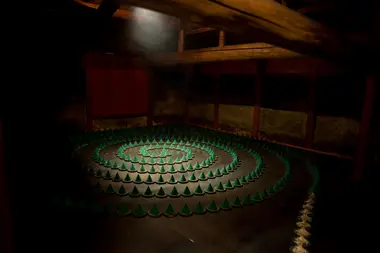Takamijima Island 高見島
- Published on : 21/05/2019
- by : I.D.O.
- Youtube
Endangered
Takamijima is part of the Shiwaku Archipelago in the Setouchi Sea. Emptied of its inhabitants, it tries to attract visitors by participating in the Setouchi Triennale, the contemporary art festival.
Increasingly deserted neighborhoods
Takamijima was once a busy port and lived off fishing and the cultivation of Dalmatian pyrethrum, a flower with repellent properties against insects, mosquitoes in particular. Today, the island is emptying of its population and has only about forty inhabitants. With its entire neighborhoods abandoned, it is a sad example of the depopulation of the islands of the Setouchi region (but other regions of Japan are also severely affected), which the Triennale project is trying to save. This is how Takamijima joined the contemporary art festival in 2013.
To read: The islands of Setouchi
Takamijima means "the island with a high view". It bears its name well since it is largely formed by Mount Ryuo (which culminates at 297 meters). It is divided into three villages including Hama, a fishing village in the southeast of the island gathering most of the population. This is also where the ferries that connect it to the port of Tadotsu, on the island of Shikoku, arrive. Further south, the hamlet of Hama is home to the Takami Hachiman shrine as well as a very special large cemetery. The tombs of Takamijima are indeed unique, they are made up of two tombs: one which houses the remains of the deceased and another next to where the family comes to gather.
Higher up, about 50 meters above the mountain, the hamlet of Ura is built on the mountainside. Its old houses dating from the Edo period (1603-1868) and its intertwined alleys make it a very picturesque landscape that was sometimes used as a filming location. Today, these beautiful, often deserted houses give the place a nostalgic charm.
The third hamlet, Itamochi, is now deserted. Only cats roam the middle of the picturesque alleys of this ghost town.
Takamijima and the Setouchi Triennial
Thirteen works by Japanese artists and elsewhere are installed in the villages of Hama and Ura in order to bring them back to life for a while...Some of them were created in previous years:
Takamijima Project/Time falls. Rays of light penetrate inside an old traditional house near the port. The exterior light is directed by the lines of an acrylic board glued to the wall and illuminates the interior. This show symbolizes the island which is at the mercy of time. By Japanese artist Kayako Nakashima.
Transition House. From the same artist. Here too, light is the common thread of the work. Hundreds of small holes, one centimeter in diameter, were installed at regular intervals in the walls and the roof of an old house in order to let in a minimum of light. The space is modulated according to the weather and the position of the sun.
Transforming form / Silent motion / Voice of Flowers・Color of Hearts. In memory of the culture of pyreths that made the island prosper, the Japanese artist Haruyuki Uchida planted pyreths with the inhabitants and installed them in an old house, rolled up like a spiral anti-mosquitoes which they are used to manufacture.
For further :
- The Seto Inland Sea
- How to get around during the Setouchi Triennale?
- The Shimanami Kaido Cycle Path
- Teshima Island
- Honjima Island
- Ibukijima Island
- Awashima Island
- Shamijima Island
- Takamijima Island
- Ogijima Island
- Megijima Island
- Takamatsu City
- Uno Harbor
- Kosan-ji Temple
- The Myths of the Seto Inland Sea Islands
- Battles and legends in the Seto Inland Sea
- Pirates and Fighters of the Seto Inland Sea
- Youkai of the Seto Inland Sea
- Naoshima's open-air works of art
Address, timetable & access
Address
Timetable
Four ferries depart daily from Tadotsu Port (5 min train ride from Marugame Station. 25 min ride). During the Setouchi Triennale, a fifth ferry will be added (one every 2-3 hrs). There will also be 6 ferries connecting Takamijima to Honjima (25 min) and Awashima (15 min).



















